The Bay class were 26 anti-aircraft frigates built for the Royal Navy under the 1943 War Emergency Programme (one cancelled, six completed as despatch vessels/survey ships). They were based on hulls of incomplete Loch class which were converted as AA frigates when it was decided to have more escorts for the british Pacific Fleet. However most arrived too late after completion in 1945 so see action. Instead they had a long cold war career. Four were transferred to the Portuguese Navy and took part inderictley to operations in Rhodesia. The last was the ex-survey vessel Dalrymple active until 1983. Porlock Bay was sold to Finland in 1962 as FNS Matti Kurki, active until 1975.
Design of the Bay class
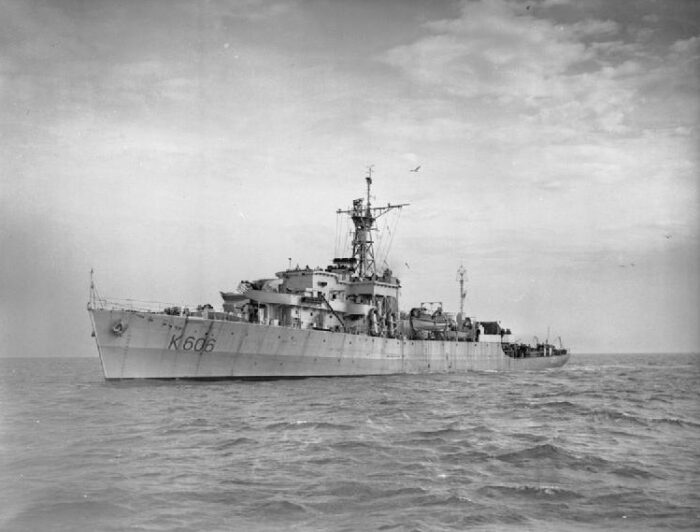
Development
The Loch class frigates were an evolution of the River class Frigates program, as an improved ASW platform and innovative design based on the experience of three years of fighting in the Battle of the Atlantic with many technological advances. Not all (mostly civilian) shipyards could build this new type, and instead turned to the simpler Castle class Corvettes. The River hull was retaken, but given an increased sheer and flare for better seakeeping and simplified shapes for pre-fabrication, with sections riveted or welded together at the shipyard, curves eliminated with a kink of the sheer forward. Their fighting capabilities were however greatly improved by the adoption as standard of the brand new Squid ahead-throwing A/S mortar.
The initial order for 54 Loch class Frigates however was never carried over in its entirety: Only 28 were completed as Loch class. For the latter hulls laid down in 1944, the admiralty reconsidered its choices. It was clear from late 1944 already that the Battle of the Atlantic was won, and focus was redirected by PM Churchill for Britain to reclaim its place and prestige in the Pacific. For this, the current far east fleet (later becoming the British Pacific Fleet or BPF) needed escorts, and the greatest danger was not from Japanese submarines, but from their Kamikaze. It was thus taken the momentous decision to convert the latter batches of the Loch class into AA ships, still capable of anti-ship and ASW work, and thus, more flexible. The focus on AA capabilities greatly depended on the choice of a new dual purpose main armament with adequate radars and equipments for detection, classification and guidance, and the standards 40mm Bofors and 20mm Oerlikons as complement for closer range.
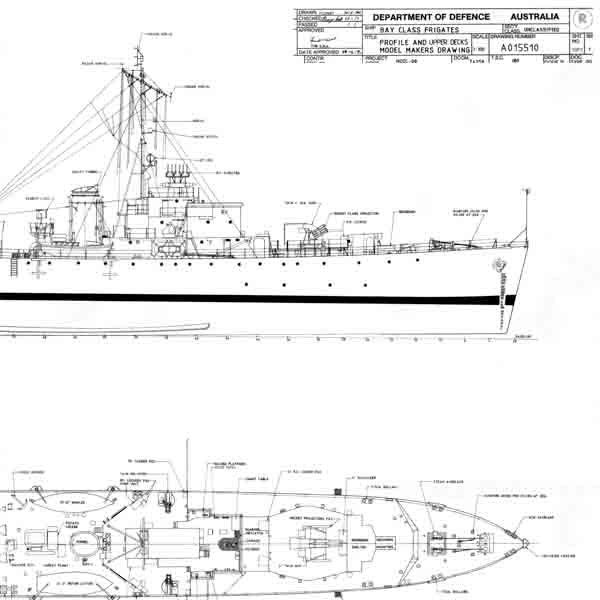
Once these choices were made, design work was done in a few months at the admiralty and the new class was named after Bays to make a clear difference. So all the ships laid down as Lochs in mid to late 1944 were renamed as Bays when launched in 1945. Unfortunately, the war of the Pacific ended well before the few operational Bay class Frigates to even proceed to the Pacific:
Bigbury Bay (K606) ex- Loch Carloway from Hall Russell, was only completed on 10 July 1945 and working out when V-Day arrived. Same for the others completed this summer and winter. But the majorit saw their construction suspended in September and resumed after a decision in early 1946. Some were even completed later, due to the layoffs in workforce and less ressources, in 1949 for example for Mounts Bay (K627) from William Pickersgill. In addition, some were delayed to be converted as desptach vessels and four as survey vessels (completed 1948-50). Filling a niche in the RN, they had long careers.
Layout
The Bay class made use of the hull, machinery, lattice mast and superstructure of incomplete Loch-class frigates. The armament was altered to suit them to the A/A role, with twin QF 4 in Mark XVI guns fore and aft in mounts HA/LA Mark XIX fitted with remote power control (RPC), controlled by a rangefinder-director Mark V carried on the bridge and fitted with Type 285 radar for range taking. Due to a shortage of supply of 4-inch (10 cm) guns and mountings, many ships had these removed from laid up V and W-class destroyer “WAIR” conversions and Hunt-class destroyers that were constructive total losses.
Powerplant of the Bay class
Like previous Frigates they were not provided with Turbines, due to shortages of the latter, reserved for destroyers, and the adoption of old school vertical triple expansion engines remained the practice, sufficient to achieve 20 knots. These were cheaper, well proven, albeit not quick to start and accelerate. They were bulkier, but also less fragile and far easier to maintain, a good fit to survive in case of a bomb hit. They provided the Bay class a steady speed and sufficient range for mid-Atlantic operations.
The Propulsion was composed of the 4-cylinder vertical triple expansion reciprocating engines driving the two shafts with 3-bladed standard bronze propellers, in turn fed by the steam from two Admiralty 3-drum boiler for a total output of 5,500 ihp (4,100 kW). Top speed on trials was 19.5 knots (36.1 km/h; 22.4 mph) but in general kept to 15 knots in escort, often less.
Range as based on an oil capacity of 724 tons for 9,500 nmi (17,600 km; 10,900 mi) at 12 knots (22 km/h; 14 mph). In absolute terms, 9,500 nmi meant largely enough for criss-crossing the Atlantic in both ways, provided they made few 19 knots ASW runs during the trip. In the Pacific however that was less impressive, but still from Sri Lanka to Mainland Japan with ease (4500 nm).
Armament of the Bay class
The Bay class had a pair of the new QF 4-in/40 Mk.XVI which benefited from faster firing and better elevation, and fire control, fore and aft. These frigates were also given a single pair of Mark V “utility” mounts, twin 40 mm Bofors sited amidships. The important difference with previous installations was their own predictive Simple Tachymetric Director (STD) was installed, making fire control deadly accurate. This AA armament also comprised a pair of twin 20 mm Oerlikon guns on the new Mark V placed on the bridge wings. Later they replaced with single mounts Mark VII Bofors guns and two more were added amidships on raised platforms. ASW capabilities were still there, with a Hedgehog on the forecastle. On the quarterdeck there were still two racks and four throwers with a provision of up to 50 depth charges of WW2 models. Below follows details.
QF 4-in/40 Mk.XVI
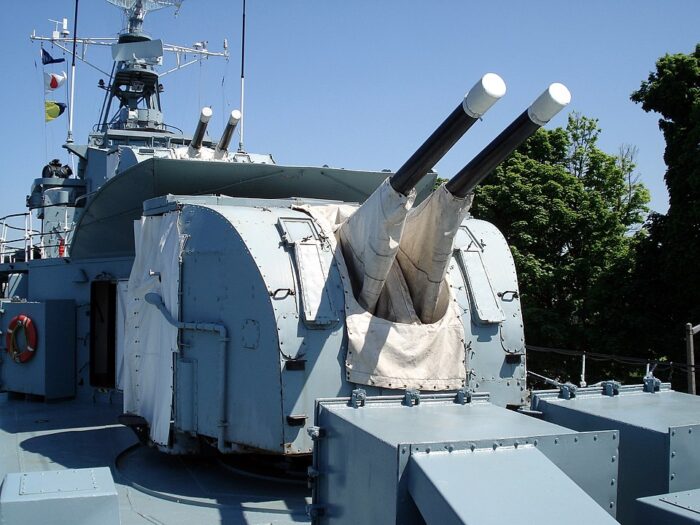
The Bay class were converted into AA frigates and were given best dual purpose 4 inches guns possible. This was the QF 4-inch Mark XVI guns on twin mounting HA/LA Mk.XIX. The 4″/45 (10.2 cm) QF Mark XVI and Mark XVI*, 4″/45 (10.2 cm) QF Mark XVII, 4″/45 (10.2 cm) QF Mark XVIII and 4″/45 (10.2 cm) QF Mark XXI were all part of a new generation of dual-purpose (DP) heavy artillery for escort ships or secondary battery on cruisers. They were designed to replace the 4″/45 (10.2 cm) Mark V HA guns of interwar cruisers.
Development started in 1934, with an entry into service in 1936 for the Mark XVI. It was constantly improved.
The first were mounted on the prototype conversion cruiser HMS Carlisle, a converted C-class, which became an AA cruiser and which shot down 11 aircraft during the war, highest score of all British cruisers. They did much better than the Didos. The Auxiliary AA ship Alynbank also shot down six. Despite of this, they were criticized for their short barrel life nor mediocre accuracy. It was later singled out as shells haing a a too-short parallel section, leading to poor centering in the muzzle.
These turrets and mounts used either the Quick Firing (QF) or Semi-Automatic (SA) modes. In the first, the breech was manually opened after firing by moving a lever ejecting the spent casing. In SA mode, the breech opened automatically after firing, ejecting itself the spent casing, making for a faster rate.
The Mark XVI was problematic as wearing out quick, so the Mark XVI* (most produced version) had its A tube replaced by an autofretted loose barrel, with a sealing collar forward of the jacket.
The Mark XVII were designed to modernize some County class cruisers bu this was not a success.
The Mark XVIII was the initial designation for the Mark XVI* and the Mark XXI was an experimental light variant with autofretted monobloc barrel and removable breech ring.
They armed or rearmed ad considerable number of ships in the RN, becoming as ubiquitous as the “pom’pom”.
The Bay class had two Twin HA/LA Mount Mark XIX mounted fore and aft behind shields.
More on navweaps
Specs
Turret weight 37,072 lbs.(16,816 kg)
Elevation, manual (15° avg) -10 to +80°, 340° traverse
Recoil 15 in (38 cm)
Range (35 lbs. HE): 45°: 19,850 yards (18,150 m). 80°: 39,000 feet (11,890 m).
Gun Length 190.5 in (4.839 m), bore 180 in (4.572 m)
Rate Of Fire: 15-20 rpm
Ammunition: Fixed Complete Round 45.13 in (114.6 cm) HE 63.5 lbs. (28.8 kg), SAP: 66.75 lbs. (30.28 kg)
Shells HE Mark 19 35 lbs. (15.88 kg), SAP 38.25 lbs. (17.35 kg).
Propellant Charge Standard Charge 9.0 lbs. SC 103/10.5 lbs. NF/S (4.09 or 4.8 kg) or 5.1 lbs. SC 061 (2.3 kg)
Cartridge 28.5 lbs. (12.9 kg).
Muzzle Velocity: Standard 2,660 fps (811 mps), reduced 2,000 fps (610 mps).
Approx. Barrel Life 600 rounds.
Magazine capacity c200 rounds
QF 20mm Oerlikon AA
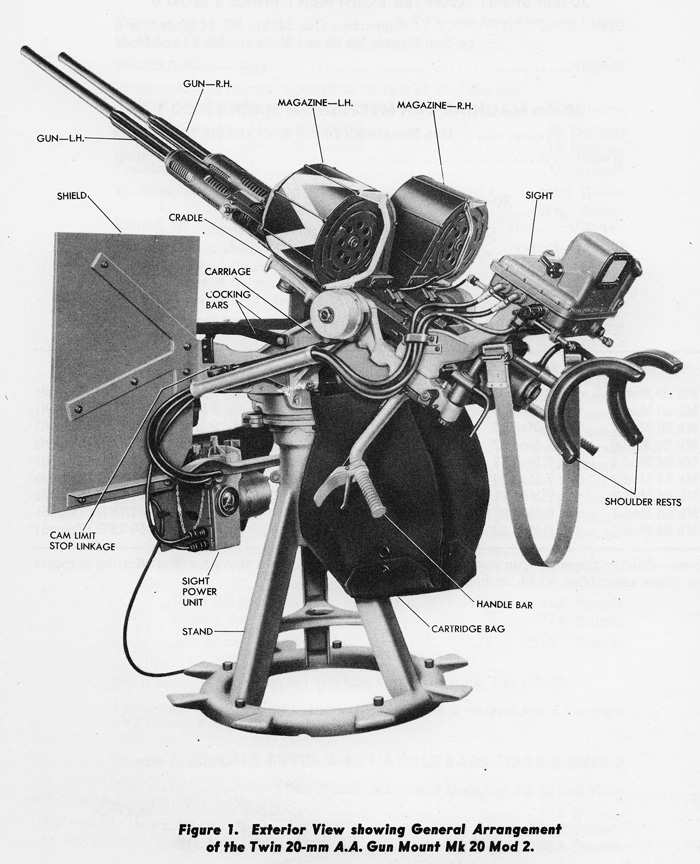
Cheaper, smaller (and thus easier to install) and more common, the US-pattern 20mm/70 Oerlikon Mk.III (single) was adopted, as well as the Mark.V twin mounts, at the same places of the former Bofors. Typically in 1944, all ships carried six ingle 20mm/70 plus six twin 20/70 Oerlikon Mk II/IV, or four twin 20mm/70 Oerlikon Mk II/IV and two single 20mm/70 Oerlikon Mk II/IV.
QF 40mm Bofors AA
40mm/60 Mk 5 were introduced in single and twin mount on modernized ships in the 1950s in replacement to the Oerlikon guns. HMS Inver received two twin 40mm/56 Bofors Mk VIII/IX/XI and two single 40/56 Bofors Mk I/III in 1944 in addition to its Oerlikon 20mm guns, and in 1945, HMS Meon and Usk had three twin 20mm/70 AA and three single 40mm/56 Bofors Mk I/III. Some were mounted in 1945 on Australian River class frigates as well.
Depth Charges
The throwers launched a DC at about 60 m on either side. On the river class eight throwers was standard, but back to four on the Bay class, and still 50 depht charges were carried total.
This was completed by two Depth Charge Racks (DCR) at the stern. The single railings hold five DCs each. There were extra railing to the aft superstructure to roll extra ones. On late River class, 140 DCs was common. Specs:
-Hand reload with winches
-Mark VII type (1939)
-420 lbs. (191 kg) overall
-290 lbs. (132 kg) TNT warhead
-Sink Rate/Terminal Velocity 9.9 fps (3.0 mps)
-Max depht setting 500 feet (182 m) from 1943.
From late 1944, the Mark X and Mark X* were introduced. The X** arrived too late but was capable of reaching 1,500 feet (457 m).
Sensors
In addition to their baseline Radar Type 285 fire control set, they had a Radar Type 291 air warning set carried at the head of the topmast plus a Radar Type 276 (later 293) target indication located at the masthead. TThey were equipped also with IFF transponders carried on the foremast (identification friend or foe) completed by a high frequency direction finder (HF/DF) carried on the short pole mainmast aft.
Type 285 (1942):
Likely the 285P (150Kw PP), 600 Mhz, 50 cm Wvlt, in service from 1942. More
Type 291 (1942):
Search radar for destroyer-sized and smaller ships, 1942: Frq 214 MHz, PRF 500/s bwt 40°, pwt 1.1 μs RA 9 nmi (17 km; 10 mi) PP 100 kW
Type 276 (1944):
Combined the Type 277 and stabilized mounting Type 273 it was a reduced 4-foot (1.2 m) antenna on an aerial outfit AUS. Aerial outfit AUS/AUJ, PP 500 kw Frq 2,997 MHz, 100mm Wvl
Conversions
Despatch conversions
Six Bays class were completed to fill a niche of the RN. HMS Dundrum Bay and Gerrans Bay became “Alert” and “Surprise” when completed. As despatch vessels they acted as commander-in-chief’s yachts for the Mediterranean and Far East Fleets respectively, lacked the Mark V Bofors mounts and aft 4-inch guns for a more developed superstructure to provide flag accommodation, and tepped tall mainmast for better radio communications with powerful sets.
Survey conversions
The four other ships were completed as survey vessels to deal with the the many uncharted wrecks and mines around the British Isles postwar whih were a navigation hazard. They were unarmed except for four 3-pounder saluting guns with shorter forward shelter decks and survey boats under davits, abreast the funnel and having a minesweeping gear aft.

⚙ Bay class specs. |
|
| Displacement | 1,600t standard, 2,530t FL |
| Dimensions | 307 ft 3 in x 38 ft 6 in x 12 ft 9 in (93.65 x 11.73 x 3.89 m) |
| Propulsion | 2 shafts VTE: 5,500 ihp (4,100 kW), 2 Admiralty 3-drum boilers |
| Propulsion* | 2 shafts 4-cyl. VTE 5,500 shp (4,100 kW), 2 Admiralty 3-drum boilers |
| Speed | 19.5 knots (36.1 km/h; 22.4 mph) |
| Range | 9,500 nmi (17,600 km; 10,900 mi) at 12 knots (22 km/h; 14 mph) |
| Armament | 1×2 QF 4-inch Mark 16, 2×2 40mm, 2×2 20mm AA, Hedgehog, 2 DCT, 4 DCR (50 DCs) |
| Sensors | Types 285 FCR, 291 AWR, 276 TIR, HF/DF, IFF |
| Crew | 157 AA Frigates, 160 Despatch, 133 Survey |
Construction and transfers
-NRP Pacheco Pereira (F337) former Bigbury Bay transfered 1959, active until 1970.
-NRP Álvares Cabral (F336) former Burghead Bay transferred 1959, active until 1971.
-NRP Dom Francisco de Almeida (F479) former Morecambe Bay, trannsferred 1961, active until 1970.
-NRP Vasco da Gama (F478) former Mounts Bay, sold 1961, active until 1971.
-NRP Afonso de Albuquerque (A526) as survey vessel, ex Dalrymple, ex- Luce Bay, ex- Loch Glass 1966-83.
-FNS Matti Kurki, ex Porlock Bay (K650) ex-Loch Seaforth, ex-Loch Muick (launched 1945), Sold to Finland in 1962, active until 1975.
 HMS Bigbury Bay (K606)
HMS Bigbury Bay (K606)
HMS Bigbury Bay was the ex-Loch Carloway, built by Hall Russell, laid down on 30 May 1944, launched 16 November 1944 and completed 10 July 1945. After sea trials she was trained and prepare to depart for the British Pacific Fleet (BPF). She made the trip via the Med, Suez, Trincomanlee and arived at her base at Hong Kong on December 1945, then carried out patrols of the Chinese coast. After a refit to Sydney by mid-1946, she took part in exercises with the USN off Japan. In February 1947 she returned to the Mediterranean Fleet, based in Haifa with the 5th Frigate Flotilla patrolling, intercept illegal Jewish immigrants vessels to British mandatory Palestine.
By March 1948, Bigbury Bay was assigned to the West Indies for nine years, with regular refits at Portsmouth and three tours of duty as guard ship to the Falkland Islands. She was regular visitor to the southern US as well as Central and South America, and on the Amazon River to Manaos in 1951, rounding Cape Horn in 1954 to visit Chile and Peru and back via Panama. By early 1957, she visited Havana, last British warship to do so until Manchester on 2010. She took part in the celebrations of Jamestown. By November 1957 she was flasghip CiC South Atlantic for exercises on South, East and West Africa. After the revolution in Iraq by July 1958 she was based at Aden for patrolling the Red Sea, Guard duty at Aqaba. In November she was back home and placed in Reserve. She was sold to Portugal in 1959, becoming the NRP Pacheco Pereira in service until 1970.
 HMS Burghead Bay (K622)
HMS Burghead Bay (K622)
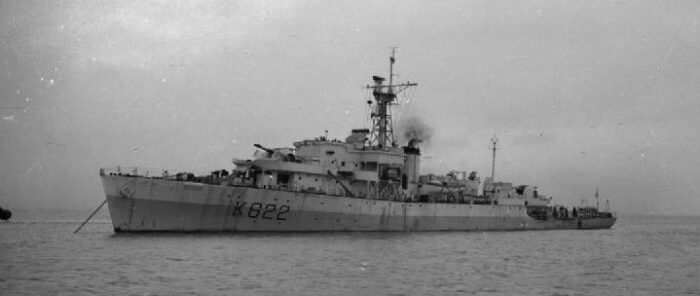
HMS Burghead Bay was the ex-Loch Harport, built by Charles Hill & Sons, laid down 21 September 1944, launched 3 March 1945 and completed 20 September 1945. After sea trials in October she was in November at the the Plymouth Flotilla until late 1952, between exercises, Channel SAR and other drills. In 1948 she became F622. In January 1952 she was at La Plata and Montevideo and proceeded to the Falkland Islands as guard ship duty, South Orkney, Graham Land, South Shetland, South Georgia in survey work. In February she was at the Hope Bay incident in Antarctica and was relieved by HMS Veryan Bay. In Bermuda she joined the West Indies Squadron (exercises and port visits) and in refit by October, completed by April 1953. She took part in the Coronation Naval Review at Spithead and back to Bermuda, then refit in June 1954 (modernization). By February 1955 she made another tour to the Falklands and bacl to Bermuda, then home refit from January 1956 until March 1957. On 24 May she was assigned to the 7th Frigate Squadron, South Atlantic Station, Simon’s Town. She visited Brazil and Argentina and had exercises between South Am and South African waters, training with the South African Navy. In early 1958 she toured East Africa and had a 3rd tour of the Falklands. She returned home via Chile, Peru, Panama Canal, Bemuda and Devonport in August, decommissioned into Reserve, on Disposal. She was sold to Portugal in 1959, as NRP Álvares Cabral (F336), serving until 1971.
 HMS Cardigan Bay (K630)
HMS Cardigan Bay (K630)
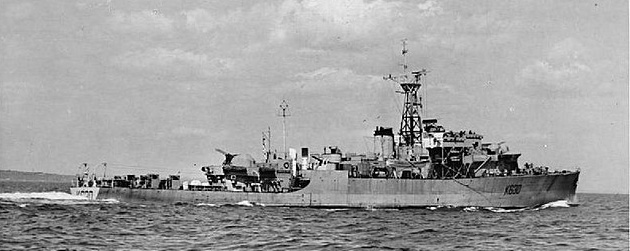
HMS Cardigan Bay was ex-Loch Laxford. She was built by Henry Robb, laid down 14 April 1944, launched 28 December 1944 and completed 25 June 1945. On 18 August 1945 she joined the Mediterranean Fleet at Malta, deployed in the Aegean Sea, Haifa (immigrant ships for Palestine), and by July 1947 escorted “Exodus” to Haifa after putting a boarding party aboard. In August she escorted the British merchant ships Empire Rival, Ocean Vigour and Runnymede Park to Port-de-Bouc near Marseille with the immigrants from Exodus back to France. By early 1948 she intercepted the Liberty ships Pan York and Pan Crescent in the Black Sea. She laso had the usual fleet exercises, port visits, surveillance tours in the Adriatic (Corfu Incident), guard ship at Trieste and Aqaba, patrolling the Red Sea. In 1948 she was F630. By July 1949, with St Brides Bay she was sent to the Eastern Fleet, Singapore station. She patorlled off Malaya and China, Yangtze Patrol with the sloop Black Swan. By October 1950 she was assigned to the United Nations British/Commonwealth support in Korea, based in Hong Kong, then Sasebo (US led UN Naval Task Group). In December she made her first tour of duty on the west coast of Korea and took part in the Inchon landing support until mid-January 1951, and back to Sasebo. Released, she returned to Hong Kong for exercises/guard ship duties. Recalled to Sasebo, she made a second Korean tour, notanly as plane guard for the carrier HMS Glory and made a coastal bombardment. In July she escorted a US LCU recovering wreckage of a Mikoyan MiG-15 crashed south-west of Hanchon while Glory and HMS Kenya provided radar and air cover. She then patrolled the Han River estuary and was refitted in Hong Kong. She made a 3rd tour from January 1952, inclusing naval gunfire until April, then Sasebo and Hong Kong with Flotilla exercises. In June she was a 5th tour and was Air Control Ship in flying operations until September. From 28 December she was assigned to the 4th Frigate Squadron and by January 1953 started a 5th tour on Korea. She hoster and carried on 7 April General Maxwell D. Taylor and Admiral Alan Scott-Moncrieff to Ch’o-do Island, Taedong River, for shore bombardment. She had a collision with the Dutch frigate Johan Maurits van Nassau and later also collided with an US Navy tug assisting. She was detached to Hong Kong in April and patrolling the coast of Malaya (insurgency). After the July 1953 armistice she made some patorls along the west coast of Korea into 1955, if not in joint exercises with USN, and rotating between Hong Kong and Singapore, Malaya, Borneo and Indonesia. She trained also with the Royal Thai Navy, Indian Navy and RAN/RNZN and SEATO. In early 1958 she made a call to New Zealand, Wellington and South Island and back to Singapore-Hong Kong until November 1960. She visited Australia, Townsville, Nouméa in New Caledonia, Suva in Fiji and Apia in Samoa, Pearl Harbor on 9 January 1961, San Francisco, San Diego, Manzanillo, Mexico, Puntarenas in Costa Rica, Panama Canal, Cartagena in Colombia, Maracaibo, Venezuela, Port of Spain, Trinidad, Bermuda and Plymouth on 7 April, a farewell before decommission, Reserve on 30 May 1961, Disposal in 1962, sold for BU.
 HMS Carnarvon Bay (K636)
HMS Carnarvon Bay (K636)

HMS Carnarvon Bay was the ex-Loch Maddy. She was built by Henry Robb, laid down 8 June 1944, launched 15 March 1945 and completed 20 September 1945. After sea trials in the winter 1945 she stayed at the Rosyth Local Flotilla from February 1946 but was placed in reduction and Reserve status, decom. in Portsmouth on 11 March, in Reserve until 1958, placed on the Disposal List, sold for BU to Genoa 5 September 1959.
 HMS Cawsand Bay (K644)
HMS Cawsand Bay (K644)
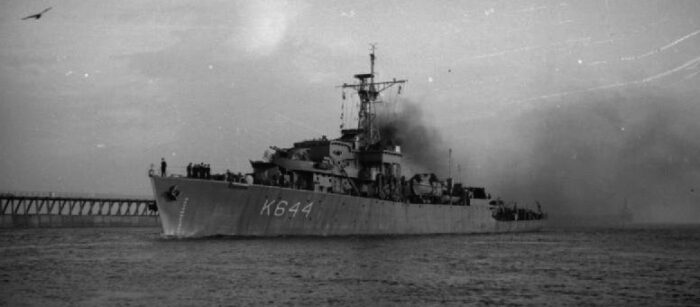
HMS Cawsand Bay was the ex-Loch Roan, built by Blyth Dry Dock, laid down 24 April 1944, launched 26 February 1945 and completed 13 November 1945. No detailed records.
 HMS Enard Bay (K435)
HMS Enard Bay (K435)
HMS Enard Bay was the ex-Loch Brachdale, built by Smiths Dock, laid down 27 May 1944, launched 31 October 1944 and completed 4 January 1946. After sea trials by December 1945-January 1946 she was assigned to the Mediterranean, Escort Flotilla at Malta from 7 February. Eastern Mediterranean, interception of immigration ships to Palestine. In August she was guard ship at Trieste and back for the same in September (interception patrols off Haifa). By January 1947 she was decommissioned back home, Plymouth Reserve Fleet, accommodation ship and Coronation celebrations in 1953. Disposal List in 1956, sold to BISCO for BU at Faslane from 15 November 1957.
 HMS Hollesley Bay (K614)
HMS Hollesley Bay (K614)
HMS Hollesley Bay was the ex- Loch Fannich, ordered from Smiths Dock, but cancelled in 1945.
 HMS Largo Bay (K423)
HMS Largo Bay (K423)
Largo Bay was the ex-Loch Foin, built by William Pickersgill, laid down 8 February 1944, launched 3 October 1944 and completed 26 January 1946. After sea trials she was assigned to the Mediterranean, joining the Escort Flotilla at Malta from 23 February 1946. Eastern Mediterranean, illegal immigrants ships to Palestine. In Marc she was at Malta for Flotilla duties. By August 1946 she was back home for decommission, Plymouth Reserve Fleet. 1953, Fleet Review for Queen Elizabeth II. Disposal List in 1958, sold for BU to BISCO Thos. W. Ward, Inverkeithing, 11 July 1959.
 HMS Morecambe Bay (K624)
HMS Morecambe Bay (K624)
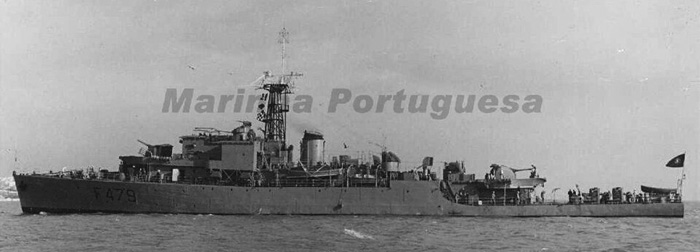
Morecambe Bay was the ex-Loch Heilen, built by William Pickersgill, laid down 30 April 1944, launched 11 November 1944 and completed 11 March 1946. Due to shortage of personnel she was in full complement by July 1946 and in August prepared for the Far East Fleet, was sent to Malta in September. Exercises with Mediterranean Fleet, then Singapore 21 November, 4th Frigate Flotilla, anti-insurgent operations off Malaya (Malayan Emergency). Mobilized for the Korean war in June 1950, sent to Sasebo in Japan. 1st TOD in October with Commonwealth ships, notably HMS Mounts Bay, HMNZS Pukaki and Tutira and by November, Task Group 95.13 for minesweeping operations. In December supported the evacuation of Inchon with CTG 95.12. January 1951 back to Hong Kong and Yangtze Patrol. In June, 2nd TOD, raids by Korean troops in the Haeju and Chojin area. In July UN TG 95.12 for bombardments off the east coast, support of allied troops ashore, congratulated by 7th Fleet Vice Admiral Harold M. Martin. RN Task Group west coast, operations off the Han River with Cardigan Bay and Mounts Bay, protected the access to Seoul, shore bombardments. Relieved, back to the flotilla in September for anti-insurgent patrols, refit at Singapore. January 1952, Malacca Strait patrols, anti-insurgent operations. February back to Sasebo, 3rd Korean TOD with CTG 95.22, Sonjin-Chojin areas, east coast. Then 4th Korean tour, September west coast, island patrols and support, East coast by October, back to to Hong Kong in November.
5th tour from May 1953, Ch’o do Island, assisted a US LST under enemy fire, then backed by USS New Jersey. August: Hong Kong for refit. Exercises, guardship at Pangyong Do in October, patrol, gunfire support. 9 December, relieved by HMS Comus, Kure, Hong Kong, fleet exercises.
January 1954, deployed for operations and patrols off Malaya. Fleet exercises in February. Hong Kong (maintenance), April patrolled the Pearl River and Formosa Strait. Last TOD in Korea in May, patrol/guardship duties. Singapore refit in July.
September, shakedown cruise off Singapore, assigned to the Caribbean, West Indies Squadron via Yokosuka, Pearl Harbor, San Francisco, Balboa in Panama to Kingston station.
January 1955 NATO fleet training with the cruisers Superb and Quebec, Bigbury Bay and Burghead Bay. UK, Portsmouth 2 February for an extensive refit until 31 July, then assigned to the America and West Indies Station from 30 September. Visited Caribbean island ports, joint exercises with HMS Kenya and USN. 1956, ports visits, Central America, US, and major multi-national exercise (USN, RN, RCN, RNN). Septembern decommissioned back home 19 November 1956. Sold to Portugal in 1961, becoming the NRP Dom Francisco de Almeida (F479), serving until 1970.
 HMS Mounts Bay (K627)
HMS Mounts Bay (K627)
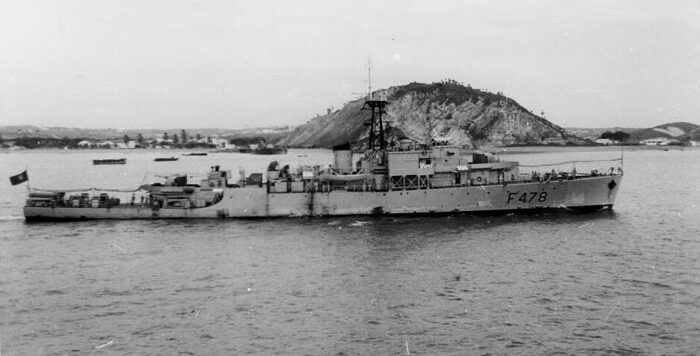
HMS Mounts Bay was the ex-Loch Kilbernie, built by William Pickersgill, laid down 23 October 1944, launched 8 June 1945 and completed 11 April 1949. No logs. In May 1960 she was decommissioned, placed into Reserve at Portsmouth, then modernized by John I Thornycroft in Southampton, and recommissioned by the Portuguese Navy after beinh sold to Portugal in 1961, becoming the NRP Vasco da Gama (F478), serving until 1971.
 HMS Padstow Bay (K608)
HMS Padstow Bay (K608)
Padstow Bay was the ex-Loch Coulside, built by Henry Robb, laid down 25 September 1944, launched 25 September 1945 and completed 11 March 1946. After sea trials she sailed to Plymouth waiting her full complement and eventually commissioned in June, then sent to the US and West Indies Station. In July she was sent to Bermuda, stopping at Ponta Delgada in the Azorest to refuel underway before reaching Bermuda on 8 August. By September-October she started many ports visits, notably Havana, Veracruz, Honduras, Jamaica, Nicaragua, Colombia, and in Venezuela, Trinidad, but also British Guiana, Paramaribo, Surinam, and Cayenne in French Guiana and back on 15 November. On 31 December her Squadron took part in exercises and man more ports visits in January 1946 followed by a routine docking at the Royal Naval Dockyard in Bermuda. From June she state a US East coast visit, with HMS Sheffield. On 1 July, she dropped anchor at Halifax in Nova Scotia, for joint exercises with the RCN. In August, she she left for the Eastern Canadian Provinces via Bathurst in New Brunswick, Ellis Bay, Anticosti, Miquelon, Argentia/St. John’s and in September Montreal with Sheffield, then back to Bermuda via Portsmouth. Sent to Plymouth on 18 November she was decommissioned, laid-up, Reserve Fleet in December and in the Reserve Fleet until 1958, on the Disposal List and sold in 1959 to BISCO, BU at La Spezia from 11 August.
 HMS Porlock Bay (K650)
HMS Porlock Bay (K650)
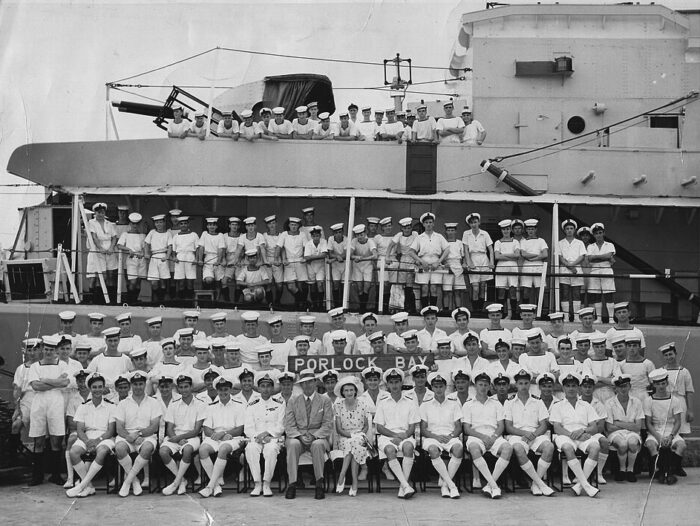
Porlock Bay was the ex-Loch Seaforth, ex-Loch Muick from Charles Hill & Sons, laid down 22 November 1944, launched 14 June 1945 and completed 8 March 1946. After sea trials she was commissioned on 14 February 1946 and sent to the America and West Indies Station. she was attached to the Plymouth Local Flotilla before sailing to Bermuda with Padstow Bay on 22 July. She had a minor collision there and missed meant the Autumn Programme of visits.
She did visited Newfoundland and Canada (St John’s 7 September) for the National Convention on the political future of the Colony. She hosted Governor Sir Gordon Macdonald for an official tour on the south coast and northern coast, visited mainland ports and stopped at Quebec on 15 October. By early November she was in joint exercises with the RCN at Halifax, then Bermuda, refitted at the Royal Dockyard. From January 1947 she took part in exercises, visited Veracruz, Mexico and Kingston, Galveston, Mobile, Key West, and back in April. In July she had official visits by the Governor of the Bahamas to the Turks and Caicos and Belize City, British Honduras after Guatemalan threats, until early August. On 12 September cuts in naval spending were announced and she was ordered home on 16 October, Devonport on 3 November, 1948 she served in the Fishery Protection Squadron and reserve at Devonport from January 1949. February she became F650 and remained in Reserve until 1962, refitted twice. She was the only one sold to Finland in 1962, becoming the FNS Matti Kurki, serving until 1975.
 HMS Veryan Bay (K651)
HMS Veryan Bay (K651)
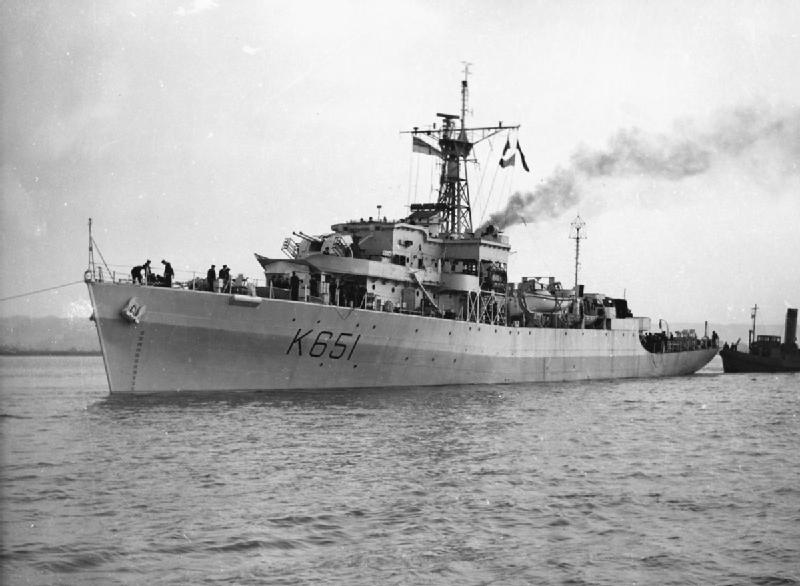
Veryan Bay was the ex- Loch Swannay) – built by Charles Hill & Sons, laid down 8 June 1944, launched 11 November 1944 and completed 13 May 1945 under Lieutenant-Commander J.S. Brownrigg. After sea trials and initial training, weapons tests, she sailed to join to the 33rd Escort Group, British Pacific Fleet, but ws underway at Malta still in exercises when the war ended.
She was in commission from 1945 to 1957, seeing service in the Pacific, Mediterranean, and Home Fleets, West Indies and South Atlantic.
To be completed at a later date.
 HMS St Austell Bay (K634)
HMS St Austell Bay (K634)
HMS St Austell Bay was the ex- Loch Lyddoch built by Harland & Wolff, laid down 30 May 1944, launched 18 November 1944 and completed 29 May 1945. She was still at Malta with other ships of the 33rd Escort Group when receicing news of the surrender of Japan arrived on 15 August 1945. In commission until 1956, she served in the Mediterranean Fleet and on the America and West Indies Squadron.
Cold War career to bo be completed at a later date.
 HMS St Brides Bay (K600)
HMS St Brides Bay (K600)
St Brides Bay was the ex-Loch Achility built by Harland & Wolff, converted as Admiralty Job No. J3902, laid down 30 May 1944, launched 16 January 1945 and completed 6 September 1945.
She was commissioned for service in the British Pacific Fleet in June 1945 but by July she sailed for Malta for escort group exercises when the deployment in the Pacific was cancelled in August. She was the reallocated to the 5th Escort Flotilla in the Mediterranean Fleet.
Cold War career to be completed at a later date.
 HMS Start Bay (K604)
HMS Start Bay (K604)
HMS Start Bay was the ex Loch Arklet built by Harland & Wolff, laid down on 8 February 1944, launched on 15 February 1945, and not completed until 6 September 1945, after the end of hostilities. She was Decommissioned a first time in November 1946, reactivated for a short career in the Mediterranean and sold for scrapping in 1958.
Cold War career to be completed at a later date.
 HMS Tremadoc Bay (K605)
HMS Tremadoc Bay (K605)
Tremadoc Bay was the ex- Loch Arnish. She was built by Harland & Wolff, laid down 31 August 1944, launched 29 March 1945 and completed 11 October 1945. This was after the war, bt after sea trials and training she had a unusual mission: Towing a German Type XXI submarine to the Baltic Sea to be handed over to the Soviet Navy. It was tantamount to give the USSR the recipe for the future Project 613 submarines, but USSR was still an ally and the share was decided under the tripartite naval agreement.
Cold War career to be completed at a later date.
 HMS Whitesand Bay (K633)
HMS Whitesand Bay (K633)
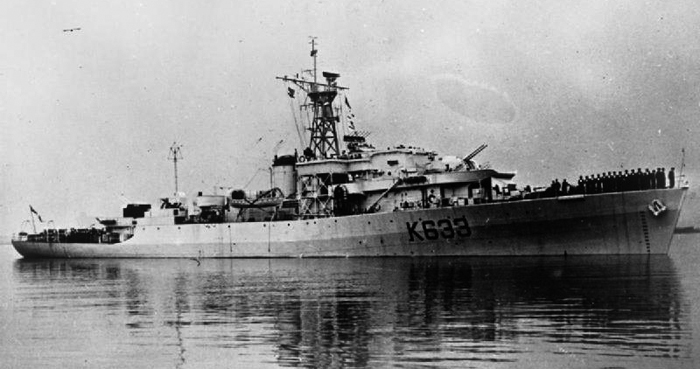
HMS Whitesand Bay was the ex- Loch Lubnaig, built by Harland & Wolff, laid down 8 August 1944, launched 16 December 1944 and completed 30 July 1945, a mere 15 days before the surrender of Japan. She was still training in home waters under Lieutenant-Commander B.C. Longbottom for service with the BPF, having sea trials at Tobermory in August, weapons testing at Portland in September. So she sailed on 5 October with Bigbury Bay for the Mediterranean Fleet underway to Hong Kong in December. She notably took part in the Korean War. She would be eventually decommissioned in December 1954.
Cold War career to be completed at a later date.
 HMS Widemouth Bay (K615)
HMS Widemouth Bay (K615)
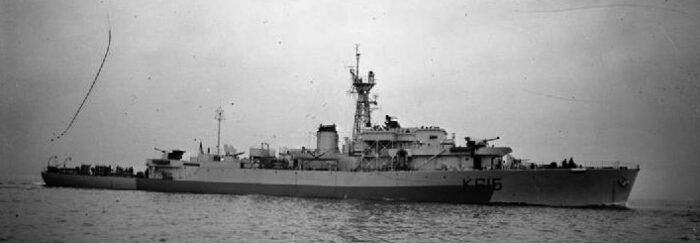
Widemouth Bay was the ex- Loch Frisa built by Harland & Wolff, laid down 24 April 1944, launched 19 October 1944 and completed 13 April 1945. She was the fasted converted in her class, and thus, saw a bit of action in WW2: After sea trials and training she sailed in July 1945 but only arrived at the forward Base of the BPF at Manus in the Admiralty Islands in August, just after the Japanese surrender. She thus still remained on the Far East Station and was relocated tot Hong Kong and in 1946, supported post-war repatriation operations if not in patrols and escort duties.
Cold War career to be completed at a later date.
 HMS Wigtown Bay (K616)
HMS Wigtown Bay (K616)
Wigtown Bay (K616) (ex- Loch Garasdale) – built by Harland & Wolff, laid down 24 October 1944, launched 26 April 1945 and completed 19 January 1946, but commissioned in November 1945 under the command of Lt-Cdr. D. Carson. She completed her fitting-out and sea trials and by February sailed to Malta and the 5th Escort Flotilla, in patrol duty in the Mediterranean Sea.
Cold War career to be completed at a later date.
 HMS Alert (K647)
HMS Alert (K647)
HMS Alert was the ex- Dundrum Bay, and ex- Loch Scamdale. She was built by Blyth Dry Dock, laid down 28 July 1944, launched 10 July 1945 and completed 24 October 1946.
Cold War career to be completed at a later date.
 HMS Surprise (K346)
HMS Surprise (K346)
Surprise was the ex- Gerrans Bay, ex- Loch Carron, built by Smiths Dock, laid down 21 April 1944, launched 14 March 1945 and completed 9 September 1946.
Cold War career to be completed at a later date.
 HMS Cook (K638)
HMS Cook (K638)
HMS Cook was the ex-Pegwell Bay, ex-Loch Mochrum laid down at William Pickersgill on 30 November 1944, launched 24 September 1945 and completed 20 July 1950 as a survey vessel.
Cold War career to be completed at a later date.
 HMS Dalrymple (K427)
HMS Dalrymple (K427)
Dalrymple was the ex- Luce Bay, ex- Loch Glass, built at William Pickersgill, laid down on 29 April 1944, launched 12 April 1945 and completed 10 February 1949. She was completed as a survey vessel. She was sold to Portugal in 1966, becoming the NRP Afonso de Albuquerque (A526), serving until 1983.
Cold War career to be completed at a later date.
 HMS Dampier (K611)
HMS Dampier (K611)
HMS Dampier was the ex-Herne Bay, ex-Loch Eil, built by Smiths Dock, laid down on 7 August 1944, launched on 15 May 1945 and completed on 14 June 1948 as a survey ship.
Cold War career to be completed at a later date.
 HMS Owen (K640)
HMS Owen (K640)
Owen was the ex- Thurso Bay, ex- Loch Muick, built by Hall Russell and laid down on 30 September 1944, launched on 19 October 1945 and completed 23 September 1949 as a survey ship.
Cold War career to be completed at a later date.
Sources
Books
J.Gardiner Conway’s all the world’s fighting ships 1922-47, p.61.
British and Empire Warships of the Second World War, H T Lenton, Greenhill Books
Royal Navy Frigates 1945-1983, Leo Marriott, Ian Allan, 1983
Links
on uboat.net/
naval-history.net/ CardiganBay.htm
naval-history.net/ StartBay
on picryl.com/
on navypedia.org
cc photos on commons.wikimedia.org
on en.wikipedia.org/ Type_276
rmg.co.uk/
battleships-cruisers.co.uk
en.wikipedia.org/ Bay-class_frigate
naval-history.net/ Bay-CawsandBay.htm
Model Kits
HMS Veryans Bay/Largo Bay APS Models 1:72.
on scalemates.com/
deansmarine.co.uk/ bayclass.html
navyhistory.au/ mas-bay-class-frigates-1945-to-1955/
whiteensignmodels.com/

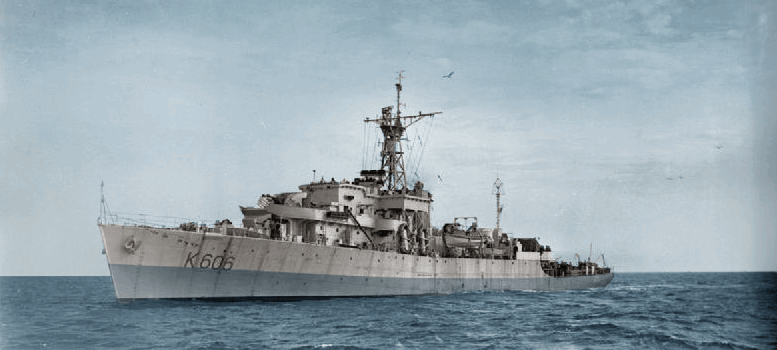

 Portuguese Navy
Portuguese Navy Finnish Navy
Finnish Navy Latest Facebook Entry -
Latest Facebook Entry -  X(Tweeter) Naval Encyclopedia's deck archive
X(Tweeter) Naval Encyclopedia's deck archive Instagram (@navalencyc)
Instagram (@navalencyc)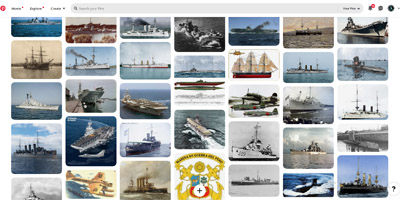

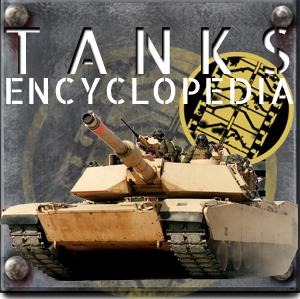
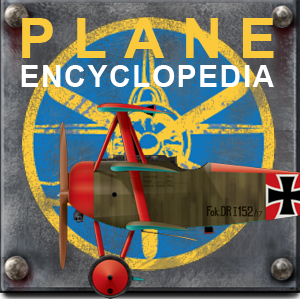
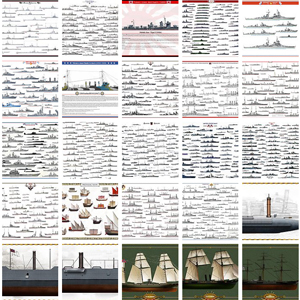
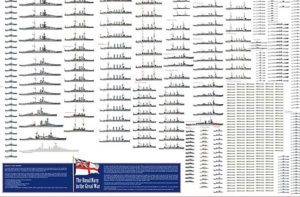
 French Navy
French Navy Royal Navy
Royal Navy Russian Navy
Russian Navy Armada Espanola
Armada Espanola Austrian Navy
Austrian Navy K.u.K. Kriegsmarine
K.u.K. Kriegsmarine Dansk Marine
Dansk Marine Nautiko Hellenon
Nautiko Hellenon Koninklije Marine 1870
Koninklije Marine 1870 Marinha do Brasil
Marinha do Brasil Osmanlı Donanması
Osmanlı Donanması Marina Do Peru
Marina Do Peru Marinha do Portugal
Marinha do Portugal Regia Marina 1870
Regia Marina 1870 Nihhon Kaigun 1870
Nihhon Kaigun 1870 Preußische Marine 1870
Preußische Marine 1870 Russkiy Flot 1870
Russkiy Flot 1870 Svenska marinen
Svenska marinen Søværnet
Søværnet Union Navy
Union Navy Confederate Navy
Confederate Navy Armada de Argentina
Armada de Argentina Imperial Chinese Navy
Imperial Chinese Navy Marinha do Portugal
Marinha do Portugal Mexico
Mexico Kaiserliche Marine
Kaiserliche Marine 1898 US Navy
1898 US Navy Sovietskiy Flot
Sovietskiy Flot Royal Canadian Navy
Royal Canadian Navy Royal Australian Navy
Royal Australian Navy RNZN Fleet
RNZN Fleet Chinese Navy 1937
Chinese Navy 1937 Kriegsmarine
Kriegsmarine Chilean Navy
Chilean Navy Danish Navy
Danish Navy Finnish Navy
Finnish Navy Hellenic Navy
Hellenic Navy Polish Navy
Polish Navy Romanian Navy
Romanian Navy Turkish Navy
Turkish Navy Royal Yugoslav Navy
Royal Yugoslav Navy Royal Thai Navy
Royal Thai Navy Minor Navies
Minor Navies Albania
Albania Austria
Austria Belgium
Belgium Columbia
Columbia Costa Rica
Costa Rica Cuba
Cuba Czechoslovakia
Czechoslovakia Dominican Republic
Dominican Republic Haiti
Haiti Hungary
Hungary Honduras
Honduras Estonia
Estonia Iceland
Iceland Eire
Eire Equador
Equador Iran
Iran Iraq
Iraq Latvia
Latvia Liberia
Liberia Lithuania
Lithuania Mandchukuo
Mandchukuo Morocco
Morocco Nicaragua
Nicaragua Persia
Persia San Salvador
San Salvador Sarawak
Sarawak Uruguay
Uruguay Venezuela
Venezuela Zanzibar
Zanzibar Warsaw Pact Navies
Warsaw Pact Navies Bulgaria
Bulgaria Hungary
Hungary

 Bundesmarine
Bundesmarine Dutch Navy
Dutch Navy Hellenic Navy
Hellenic Navy Marina Militare
Marina Militare Yugoslav Navy
Yugoslav Navy Chinese Navy
Chinese Navy Indian Navy
Indian Navy Indonesian Navy
Indonesian Navy JMSDF
JMSDF North Korean Navy
North Korean Navy Pakistani Navy
Pakistani Navy Philippines Navy
Philippines Navy ROKN
ROKN Rep. of Singapore Navy
Rep. of Singapore Navy Taiwanese Navy
Taiwanese Navy IDF Navy
IDF Navy Saudi Navy
Saudi Navy Royal New Zealand Navy
Royal New Zealand Navy Egyptian Navy
Egyptian Navy South African Navy
South African Navy






























 Ukrainian Navy
Ukrainian Navy dbodesign
dbodesign